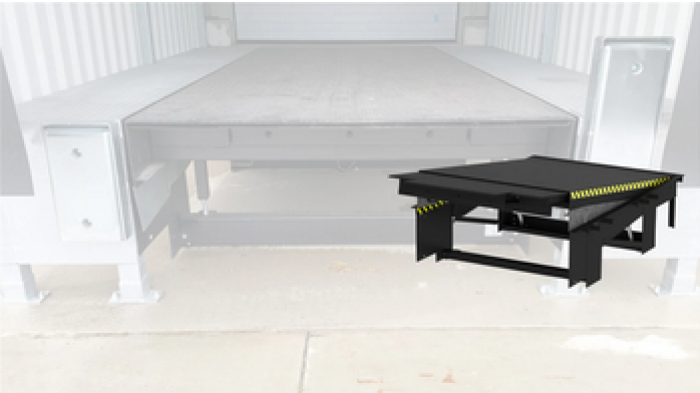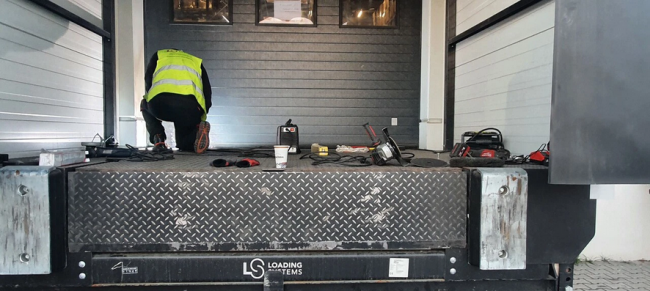Dock levellers simplify your loading and unloading operations by increasing efficiency, preventing damage and promoting safety. Today, choosing the right dock leveller for your facility can be more complicated than ever. As new models are introduced, more and more diverse vehicles are loading and unloading at the loading bay. In addition, productivity is crucial whilst safety should not suffer. Determining the right dock leveller is a crucial element when putting together the loading bay. Therefore, in this blog we would like to give some tips on choosing the right leveller.
What is a dock leveller?
Simply put, a dock leveller bridges the gap between the loading bay and the docked vehicle. Therefore, it is a useful tool that makes the workplace a lot safer for your employees. However, it is of course only a useful tool if it fits the dock and the goods to be loaded.
We therefore advise you, before choosing the type and size of Dock Levellers, to make an inventory of the trucks to be received, the internal transport means and the goods to be loaded.
Different types of dock levellers
It is good to know which dock levellers are available to determine which is most suitable for your specific situation. Every loading bay and vehicle is different. Therefore, it is important to choose the right dock leveller. But which options do you have?
- Swing lip; the swing lip dock leveller is mostly used for situations where standard vehicles operate. This allows safe unloading with minimal lost time.
- Telescopic lip; with the telescopic lip dock levellers, you just bridge a larger connection surface between the dock leveller and the loading floor. Due to the extremely precise positioning, the loading and unloading process can take place very safely.
- Manually operated; no room for a traditional dock leveller? No problem! By using the manually operated dock leveller, loading and unloading can still be carried out economically and reliably. The dock leveller is easy to use and very energy-efficient as no power source is required.
- Combidock leveller; is the leveller for flexibility. This is because the leveller can be used for vans as well as large trucks. This avoids the unnecessary use of many levellers.
- Van-Dock leveller; the growth of the e-commerce industry has created a new development within the market, namely a dock leveller specifically for vans.
This way, the dock leveller can be tailored to your situation; the weight the leveller needs to carry and the height to be bridged.
Dock leveller length
The length of the dock leveller is determined by the maximum acceptable gradient for internal transport and the goods to be loaded. If there is a large difference in level between the vehicle and the loading bay, the dock leveller should be longer. It is important to take stock of the external transport traffic beforehand, taking into account the maximum gradient angles of the internal transport means you need.
Dock leveller width
The width of the dock leveller is determined by the trucks dimensions, the type of goods to be loaded and the internal transport means. In most situations, we recommend choosing the widest possible dock leveller (for the situation in will be applied to) as this facilitates the positioning of the load. Especially in the situation where loading is required below platform level and the available space on the platform is limited by pit edges.
Dock leveller capacity
Capacity is one of the most critical specifications when choosing the right dock leveller. An incorrect choice of loading capacity can lead to accidents. In addition, there is a risk of irreparable damage to the system. To determine the required load capacity, it is important to know the total train weight; weight of internal means of transport + driver + heaviest load.
In what circumstances is a higher load capacity required?
- Driving up at high speeds combined with abrupt braking
- Very intensive use
- Internal transporters with small wheels
Need help choosing the right dock leveller? Then contact us today! With over 55 years of experience, we can help you put together a dock leveller best suited for application in your specific situation.
Accessories; for extra safety and efficiency
The loading and unloading bay is one of the most dangerous areas of a warehouse. Safety is therefore an important aspect. After all, safe working methods contribute to the well-being of people and goods.
Toe guards
As standard, our dock levellers are equipped with toe guards. Toe guards are installed on the sides of the dock leveller and cover the open area between the leveller and the platform (when loading above platform level).
Foam insulation
The steel upper deck of the dock leveller has a lower insulation value. A lot of hot or cold air loss can therefore occur here. By insulating the underside with foam insulation, the dock leveller is well insulated. Substantial savings can thus be made on energy costs.
Air seals
Air seals are a minor intervention with a major impact. To increase the insulation values even further, the sides and rear of the dock leveller can be fitted with air seals. These ensure that any gaps are sealed completely flexibly. Draught prevention can lead to savings in energy costs and a better working environment.
For more information about our accessories for the loading bay please read here!
Dock levellers simplify your loading and unloading operations by increasing efficiency, preventing damage and promoting safety. Today, choosing the right dock leveller for your facility can be more complicated than ever. As new models are introduced, more and more diverse vehicles are loading and unloading at the loading bay. In addition, productivity is crucial whilst safety should not suffer. Determining the right dock leveller is a crucial element when putting together the loading bay. Therefore, in this blog we would like to give some tips on choosing the right leveller.
What is a dock leveller?
Simply put, a dock leveller bridges the gap between the loading bay and the docked vehicle. Therefore, it is a useful tool that makes the workplace a lot safer for your employees. However, it is of course only a useful tool if it fits the dock and the goods to be loaded.
We therefore advise you, before choosing the type and size of Dock Levellers, to make an inventory of the trucks to be received, the internal transport means and the goods to be loaded.
Different types of dock levellers
It is good to know which dock levellers are available to determine which is most suitable for your specific situation. Every loading bay and vehicle is different. Therefore, it is important to choose the right dock leveller. But which options do you have?
- Swing lip; the swing lip dock leveller is mostly used for situations where standard vehicles operate. This allows safe unloading with minimal lost time.
- Telescopic lip; with the telescopic lip dock levellers, you just bridge a larger connection surface between the dock leveller and the loading floor. Due to the extremely precise positioning, the loading and unloading process can take place very safely.
- Manually operated; no room for a traditional dock leveller? No problem! By using the manually operated dock leveller, loading and unloading can still be carried out economically and reliably. The dock leveller is easy to use and very energy-efficient as no power source is required.
- Combidock leveller; is the leveller for flexibility. This is because the leveller can be used for vans as well as large trucks. This avoids the unnecessary use of many levellers.
- Van-Dock leveller; the growth of the e-commerce industry has created a new development within the market, namely a dock leveller specifically for vans.
This way, the dock leveller can be tailored to your situation; the weight the leveller needs to carry and the height to be bridged.
Dock leveller length
The length of the dock leveller is determined by the maximum acceptable gradient for internal transport and the goods to be loaded. If there is a large difference in level between the vehicle and the loading bay, the dock leveller should be longer. It is important to take stock of the external transport traffic beforehand, taking into account the maximum gradient angles of the internal transport means you need.
Dock leveller width
The width of the dock leveller is determined by the trucks dimensions, the type of goods to be loaded and the internal transport means. In most situations, we recommend choosing the widest possible dock leveller (for the situation in will be applied to) as this facilitates the positioning of the load. Especially in the situation where loading is required below platform level and the available space on the platform is limited by pit edges.
Dock leveller capacity
Capacity is one of the most critical specifications when choosing the right dock leveller. An incorrect choice of loading capacity can lead to accidents. In addition, there is a risk of irreparable damage to the system. To determine the required load capacity, it is important to know the total train weight; weight of internal means of transport + driver + heaviest load.
In what circumstances is a higher load capacity required?
- Driving up at high speeds combined with abrupt braking
- Very intensive use
- Internal transporters with small wheels
Need help choosing the right dock leveller? Then contact us today! With over 55 years of experience, we can help you put together a dock leveller best suited for application in your specific situation.
Accessories; for extra safety and efficiency
The loading and unloading bay is one of the most dangerous areas of a warehouse. Safety is therefore an important aspect. After all, safe working methods contribute to the well-being of people and goods.
Toe guards
As standard, our dock levellers are equipped with toe guards. Toe guards are installed on the sides of the dock leveller and cover the open area between the leveller and the platform (when loading above platform level).
Foam insulation
The steel upper deck of the dock leveller has a lower insulation value. A lot of hot or cold air loss can therefore occur here. By insulating the underside with foam insulation, the dock leveller is well insulated. Substantial savings can thus be made on energy costs.
Air seals
Air seals are a minor intervention with a major impact. To increase the insulation values even further, the sides and rear of the dock leveller can be fitted with air seals. These ensure that any gaps are sealed completely flexibly. Draught prevention can lead to savings in energy costs and a better working environment.
For more information about our accessories for the loading bay please read here!
















